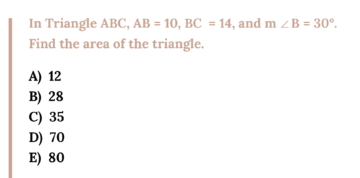The ACT Math section is often the most challenging for students, as most of your score increases will come from sheer knowledge accumulation. In fact, in recent years the test has actually gotten harder, testing several more advanced topics than the SAT. That said, the simple questions are still very simple, and the patterns in the more difficult questions are undeniable. Our strategies below will help you make sense of this test, and with practice, you will undoubtedly see increases.
1. Think in ‘mini-tests’
Questions 1-30 constitute your easy, 20-25 minute test. Questions 31-50, your 20-minute, medium-level test. Questions 51-60, your final, difficult test. If you allot yourself a maximum of two incorrect answers on your first mini-test, three to five on your second, and three to five on your third, you are on your way to a 30. Believe that it is doable, because it is!
2. Understand mistakes before moving forward
It should go without saying, but as you study, do not cheat yourself. Understand your errors fundamentally. Ask yourself, “Would I be able to teach this particular question to a classmate in two+ ways?” If not, stick with it until you can. Get the most out of every practice test by addressing every issue involved in incorrect answers. A practice test is not over until you have reviewed and mastered all of your problem areas.
3. Practice programs
Students go crazy on this test with calculator programs. They can be extremely helpful, but they can also be very confusing and overwhelming. If you’re going to download programs, make sure you are as proficient as possible beforehand.
4. Puzzle approach
Think of these problems as puzzles or riddles, rather than straightforward math problems. When you’re solving a logic puzzle (jigsaw, crossword, word jumbles, mazes, etc.), you don’t just stop and panic after your first attempt fails, do you? Apply that logic here: If you get stuck in one way, try another, and another, and another. There are multiple ways to do every single problem on this test, so let’s see if you can come up with a Plan A, B, and C for given problems. Specifically:

Now, the most direct way to solve this problem is by knowing the trigonometric area of a triangle formula, A = ½ absin(C°). However, if that direct Plan A slipped your mind, you might try Plan B: drawing it out.
When you do draw things out, it is exceedingly important that you draw them to scale. When you do, you find that in this particular problem, the height appears to be slightly less than 10. Applying our traditional area formula, A = 12 (base) (height), should then give us an area that’s at least relatively close to C (35).
Lastly, a Plan C might include working backwards and eliminating implausible answer choices, estimating with 30-60-90 triangles, or using a calculator program (read: Strategy 3). The choice(s) are yours.
5. Anticipate silly mistakes
For those particularly prone to careless errors, get in the habit of thinking, “What silly mistake could I make here?” Missing negative signs, distributing poorly, solving for the wrong unit — all of these are typical examples, but certainly not exhaustive. Those sneaky test makers have incorporated a potential careless pitfall in every problem. Identify them and avoid.


